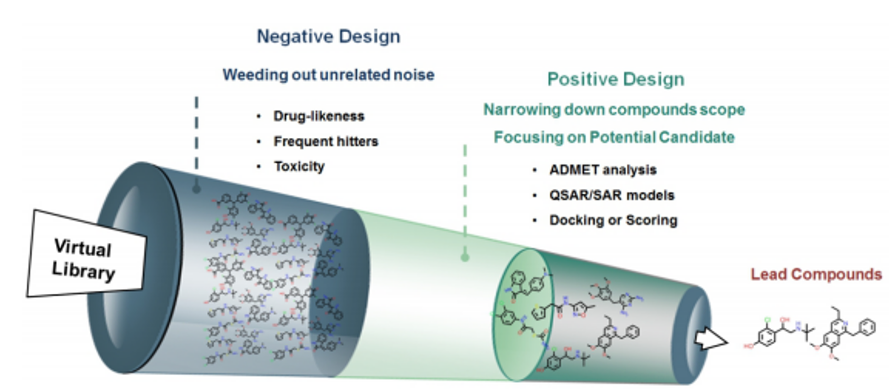At the beginning of drug discovery projects, a battery of simple but effective negative design methods have usually been employed to eliminate molecules with undesired properties. To improve the success rate and reduce unnecessary costs, different screening strategies have been developed and widely applied. They can be divided into two categories according to the design aim: negative design and positive design. These negative design methods are able to filter out compounds with undesired properties and thus obtain the desired VS (virtual screening) library for further screening in drug discovery.
 Figure 1. Popular negative and positive designs. (Ziyi Yang, et al. 2020)
Figure 1. Popular negative and positive designs. (Ziyi Yang, et al. 2020)
Negative Design Methods for Evaluation of Drug-Likeness
Drug-likeness explores the relationship between molecular characteristics and behaviors in vivo. Drug-likeness focuses on potential candidates for further research and production, while lead-likeness intends to explore compounds that are tractable for chemical optimization. It should be noted that most drug-likeness rules were intended for the screening of orally administered drugs, while relatively few rules were specifically designed for natural drugs or macrocycle molecules. Such multiparameter optimization strategies can be applied in more negative designs for achieving simplicity, flexibility, and visualization at the same time.
Negative Design Methods for Evaluation of Frequent Hitters
It is found that a large number of compounds are repetitively identified as active hits in many different and independent biological assays covering a wide range of targets, called "frequent hitters". They have a clear-cut negative connotation, as molecular promiscuity is often associated with nontherapeutic "off-targets". Accurate prediction of specific mechanism of frequent hitters is critical in the early phases of drug discovery.
Negative Design Methods for Evaluation of Toxicity
Toxicity remains a significant issue for the pharmaceutical industry, which may lead to unexpected attrition, late-stage failures, and market withdrawals. It is clear that a key strategy to reduce toxicity-related attrition and cost is to target safe and potential compounds in the early phase. The knowledge-based rules or filters and the models developed by several simple statistical methods, make negative design a better choice for early target screening.
To achieve efficient and successful drug researches, a set of negative design tools have been developed for improving drug discovery efficiency and making decisions with abundant and high-quality data. It is a process of multi-step and multi-parameter optimization to use early phase screening results as a flag list, rather than a set of stringent elimination criteria. We believe that the development and rational application of negative design can take our drug research and development path better and further, and truly realize the effective and reasonable research and development of potential drugs.
References
- Ziyi Yang, et al.; Application of Negative Design to Design a More Desirable Virtual Screening Library. Journal of Medicinal Chemistry, 2020.
- Ajay Walters, et al.; Can We Learn to Distinguish between Drug-like and Nondrug-like Molecules? J. Med. Chem, 1998, 41: 3314-3324.
- Paul, S. M. et al.; How to Improve R&D Productivity: The Pharmaceutical Industry's Grand Challenge. Nat. Rev. Drug Discovery, 2010, 9: 203-214.